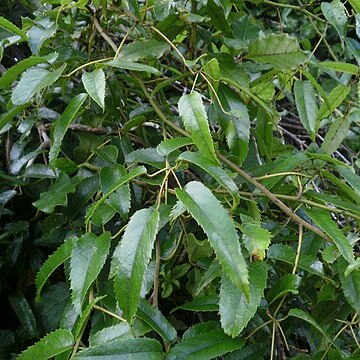Liane up to 15 m. or more tall, with very stout main stems up to 1 dm. or more diam., much-branched; branches us. unarmed, branchlets with stout recurved reddish prickles. Lvs quinate, occ. ternate, aculeate-serrate, coriac., glab., fine veins us. distinct, petioles and petiolules us. armed with recurved prickles, stipules narrow-linear; lamina polymorphic: (a) narrow linear-lanceolate, acuminate, submembr., 7-15 cm. × 3-10 mm., truncate to shallowly cordate at base (not seen flowering in this form); (b) ovate-lanceolate, acute to acuminate, rarely obtuse, coriac., 6-15 × 2-3 cm., subcordate at base; (c) broadly ovate-oblong to oblong, acute to acuminate, or occ. obtuse, 6-15 × 3-6 cm., truncate to oblique at base. Forms intermediate between (b) and (c) are common. Fls unisexual, in us. large much-branched panicles up to 6 dm. long; branchlets and pedicels glandular-pubescent; sepals pubescent, pale-margined, ovate-oblong, obtuse, 3-5 mm. long; petals 5, white, 5-8 mm. long, ovate to oblong or obovate; stamens ∞; frs 5-10 mm. long, drupelets ∞, flesh orange-red.
More
Scrambling liane; stems stout, terete, glabrate, often with scattered stalked glands when young; armature of numerous, stout, falcate, reddish prickles. Lvs palmate; leaflets (3)-5, glabrate, evenly and usually sharply serrate, usually lanceolate, sometimes ovate-oblong, ovate or linear; terminal leaflet lamina 40-150 × 7-60 mm, with petiolule c. ⅕-⅔ or rarely = or > length of lamina. Infl. a much-branched, many-flowered panicle up to 60 cm long. Petals white. Drupelets orange to red.
A thorny vine. The leaves can be 15 cm long. The fruit are berries. They are edible.
Can be grown by cuttings or seedlings. Seeds needs stratification.

